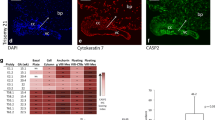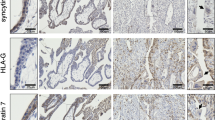Abstract
Villous trophoblast in the human placenta consists of a population of proliferating stem cells which differentiate and individually fuse into the syncytiotrophoblast. We studied the apoptotic cascade in this complex epithelial layer by immunohistochemical localization of Fas, FasL, Bcl-2, Mcl-1, pro-caspase-3 and caspase-3, T-cell-restricted intracellular antigen-related protein (TIAR), poly(ADP-ribose) polymerase (PARP), lamin B, topoisomerase IIα, and transglutaminase II in cryostat and paraffin-fixed tissue sections from normal human first-trimester and term placental villi. The relationship between the apoptotic cascade and syncytial fusion was studied by coincubation of intact villi with FITC-coupled annexin-V, to detect the phosphatidylserine flip, and propidium iodide, to detect plasma membrane permeability. The final events of the apoptotic cascade were studied by the TUNEL reaction and ultrastructural appearance of the trophoblast. The phosphatidylserine flip was identified in some of the villous cytotrophoblastic cells, but the presence of both Bcl-2 and Mcl-1 proteins presumably prevented continuation of the apoptotic cascade. The syncytiotrophoblast demonstrated heterogeneous findings, suggesting variable progression along the apoptotic cascade. In some areas Bcl-2 and Mcl-1 predominated, with preservation of the nuclear proteins PARP, lamin B, and topoisomerase IIα; in other areas, especially in and around syncytial sprouts, Bcl-2 and Mcl-1 were absent, accompanied by loss of nuclear proteins, presence of phosphatidylserine flip, and TUNEL positivity. These data suggest that the apoptotic cascade is initiated in the villous cytotrophoblast, which in turn promotes syncytial fusion. Donation of anti-apoptotic proteins into the syncytium, such as Bcl-2 and Mcl-1, focally inhibits further progression along this cascade. Completion of the apoptotic cascade takes place in and around syncytial sprouts, providing further evidence that these are the sites of trophoblast shedding into the maternal circulation.
Similar content being viewed by others
Author information
Authors and Affiliations
Additional information
Accepted: 29 May 1998
Rights and permissions
About this article
Cite this article
Huppertz, B., Frank, HG., Kingdom, J. et al. Villous cytotrophoblast regulation of the syncytial apoptotic cascade in the human placenta. Histochemistry 110, 495–508 (1998). https://doi.org/10.1007/s004180050311
Issue Date:
DOI: https://doi.org/10.1007/s004180050311




